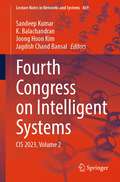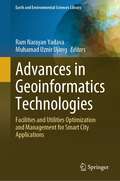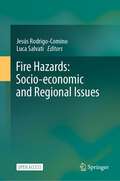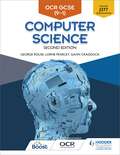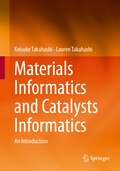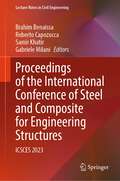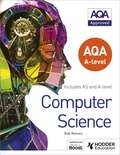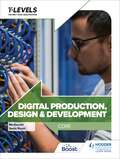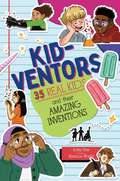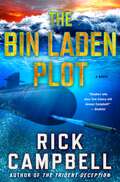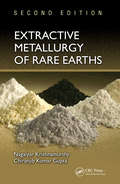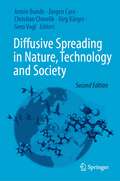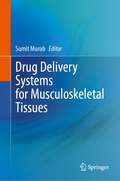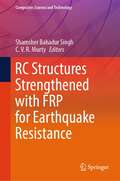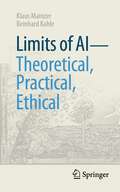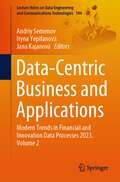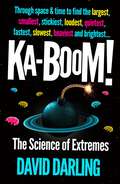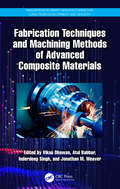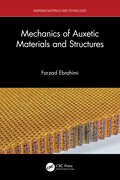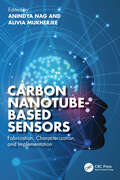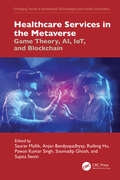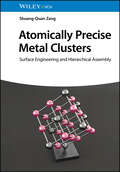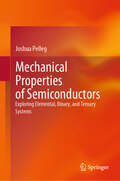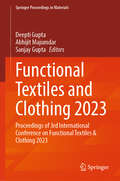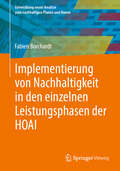- Table View
- List View
Fourth Congress on Intelligent Systems: CIS 2023, Volume 2 (Lecture Notes in Networks and Systems #869)
by Sandeep Kumar K. Balachandran Joong Hoon Kim Jagdish Chand BansalThis book is a collection of selected papers presented at the Fourth Congress on Intelligent Systems (CIS 2023), organized by CHRIST (Deemed to be University), Bangalore, India, under the technical sponsorship of the Soft Computing Research Society, India, during September 4–5, 2023. It includes novel and innovative work from experts, practitioners, scientists, and decision-makers from academia and industry. It covers topics such as the Internet of Things, information security, embedded systems, real-time systems, cloud computing, big data analysis, quantum computing, automation systems, bio-inspired intelligence, cognitive systems, cyber-physical systems, data analytics, data/web mining, data science, intelligence for security, intelligent decision-making systems, intelligent information processing, intelligent transportation, artificial intelligence for machine vision, imaging sensors technology, image segmentation, convolutional neural network, image/video classification, soft computing for machine vision, pattern recognition, human-computer interaction, robotic devices and systems, autonomous vehicles, intelligent control systems, human motor control, game playing, evolutionary algorithms, swarm optimization, neural network, deep learning, supervised learning, unsupervised learning, fuzzy logic, rough sets, computational optimization, and neuro-fuzzy systems.
Advances in Geoinformatics Technologies: Facilities and Utilities Optimization and Management for Smart City Applications (Earth and Environmental Sciences Library)
by Ram Narayan Yadava Muhamad Uznir UjangThere are many GIS products for smart cities to implement smart city projects or activities. Most of the Geoinformatics Technologies and its application books are theoretical and lack of examples with real world data and step by step explanations to understand the facilities and utilities optimization and management for smart city applications and socio-economic aspects.This book focuses and discusses topics related to how technological advances in Geoinformatics can help in the management operations of smart city applications to help our environment to be smart. Specifically, the volume focuses on how these advancements can help optimize and manage facilities and utilities. This book focuses on geoinformation modelling, geo-smart city applications, geoinformation technology, information system and computer science, and geolocation and positioning as its five primary areas of discussion. Each of these primary subjects delves into the application that uses geoinformatics technology in greater depth. This covers the use of Geoinformatics technology in the prevention of crime, coastal erosion, carbon emission modelling, landslide modelling, urban farming, and various other applications linked to the field. This book's objective is to provide a comprehensive review of the accomplishments that geoinformatics has made in a number of different application areas for smart cities. It covers Geoinformation Technologies, Geoinformation Modelling, Information System and Computer Science, Geolocation & Positioning, and Geo-Smart City Applications.The book will be useful to graduate students, university faculty, and researchers in Geoinformatics sciences/engineering and architecture and town planning. It will also be useful to entrepreneurs, professionals, and planners in policy and decision making at the local, state and national levels.
Fire Hazards: Socio-economic and Regional Issues
by Jesús Rodrigo-Comino Luca SalvatiThe open access book aims to show the readers novel, relevant and reproducible power of synergistic collaborations between European research groups and stakeholders with the objective to synthesize the existing knowledge and expertise about fire management and hazard and defining a concerted research agenda that promotes an integrated approach to create fire-resilient landscapes, taking into account biological, biochemical and physical, but also socio-economic, historical, geographical, sociological, perception and policy constraints. This is an urgent societal need due to the expected further intensification and geographical spreading of wildfire regimes under Global Change. Fire has been part of the Earth's System for the last 400 million years, and humans are the sole species that controls and manages fire. We have used fire for over a million years, both, as hunter-gatherers managing the landscape with fire and as farmers using fire as a low-cost, efficient and ecological tool for clearing and maintaining the productivity of the land. Fire has been highlighted as the most influential element in the development of human societies. The increase in prolonged dry and hot periods observed in many regions of the world is exacerbating the risk of fire. The causes of increased fire risk are not only linked to climate change but are also a consequence of economic and social changes and political decisions. Over the past few decades, many countries’ rural areas have seen significant depopulation and a reduction in land management as residents moved to cities or even other countries in search of work. The resulting rural depopulation has led to revegetation of the abandoned agricultural land, which favors fire spread. The enhanced risk of fires is moving beyond the capacity of even the best-funded wildland firefighting teams and therefore calls for the development of new approaches to fire management that are key nowadays at different scales. Instead of focusing primarily on increasing firefighting capabilities, a more effective approach is needed that focuses on long-term fire prevention through vegetation management by reducing fuel load or managing fuel type and fuel continuity at a landscape level. FIRElinks (COST Action CA18135) is developing the EU-spanning network of scientists and practitioners involved in forest fire research and land management with backgrounds such as fire dynamics, fire risk management, fire effects on vegetation, fauna, soil and water and socio-economic, historical, geographical, political perception and land management approaches. Among the different Working Groups, number 5 is aimed to connect communities from different scientific and geographic backgrounds, allowing the discussion of different experiences and the emergence of new approaches to fire research, human management, regional issues and socio-economic aspects.
OCR GCSE Computer Science, Second Edition
by George Rouse Lorne Pearcey Gavin Craddock Ian PagetWritten by leading Computer Science teachers, this brand-new textbook will guide students through the updated OCR GCSE Computer Science specification topic by topic, and provide them with standalone recap and review sections, worked examples and clear explanations of complex topics.This Student Book:>> develops computational thinking skills in line with the new Practical Programming element of Component 02>> provides differentiated material with the 'beyond the spec' feature>> includes standalone recap and review sections at the end of each chapter>> includes answers to the Knowledge Check questions to support independent learning>> provides definitions of technical terms, along with a glossary of words that will be needed for assessment.Looking for answers for the Student Book? They can be found at the back of the print textbook.You can now access a free set of practice questions on the Hodder Education website. Please note, these questions are not endorsed by OCR and have not been subject to any OCR quality assurance processes.George Rouse, Lorne Pearcey and Gavin Craddock are highly respected and widely published authors of resources.
Materials Informatics and Catalysts Informatics: An Introduction
by Keisuke Takahashi Lauren TakahashiThis textbook is designed for students and researchers who are interested in materials and catalysts informatics with little to no prior experience in data science or programming languages. Starting with a comprehensive overview of the concept and historical context of materials and catalysts informatics, it serves as a guide for establishing a robust materials informatics environment. This essential resource is designed to teach vital skills and techniques required for conducting informatics-driven research, including the intersection of hardware, software, programming, machine learning within the field of data science and informatics. Readers will explore fundamental programming techniques, with a specific focus on Python, a versatile and widely-used language in the field. The textbook explores various machine learning techniques, equipping learners with the knowledge to harness the power of data science effectively. The textbook provides Python code examples, demonstrating materials informatics applications, and offers a deeper understanding through real-world case studies using materials and catalysts data. This practical exposure ensures readers are fully prepared to embark on their informatics-driven research endeavors upon completing the textbook. Instructors will also find immense value in this resource, as it consolidates the skills and information required for materials informatics into one comprehensive repository. This streamlines the course development process, significantly reducing the time spent on creating course material. Instructors can leverage this solid foundation to craft engaging and informative lecture content, making the teaching process more efficient and effective.
Proceedings of the International Conference of Steel and Composite for Engineering Structures: ICSCES 2023 (Lecture Notes in Civil Engineering #486)
by Brahim Benaissa Roberto Capozucca Samir Khatir Gabriele MilaniThis volume provides the latest developments in the field of steel and composite for engineering applications, as presented at the International Conference on Steel and Composite for Engineering Structures (ICSCES), held in Lecce, Italy on November 20-21, 2023. It covers interest topics like control and vibration, damage in composite materials, fracture and damage mechanics, construction management, damage tolerance, safety, security, and reliability, big data analytics, topology optimization and artificial intelligence, mechanical and material engineering, structural health monitoring, computer-aided design and manufacturing, crack initiation and propagation, performance and optimization, computational fracture mechanics, inverse problem, non-destructive testing, signal processing, artificial intelligence. It serves as a reference work for professionals and students in the areas of civil engineering, applied natural sciences and engineering management.
AQA A level Computer Science
by Bob ReevesExam Board: AQALevel: AS/A-levelSubject: Computer ScienceFirst Teaching: September 2015First Exam: June 2016This title has been approved by AQA for use with the AS and A-level AQA Computer Science specifications. AQA A-level Computer Science gives students the chance to think creatively and progress through the AQA AS and A-level Computer Science specifications. Detailed coverage of the specifications will enrich understanding of the fundamental principles of computing, whilst a range of activities help to develop the programming skills and computational thinking skills at A-level and beyond. - Enables students to build a thorough understanding of the fundamental principles in the AQA AS and A-Level Computer Science specifications, with detailed coverage of programming, algorithms, data structures and representation, systems, databases and networks, uses and consequences.- Helps to tackle the various demands of the course confidently, with advice and support for programming and theoretical assessments and the problem-solving or investigative project at A-level.- Develops the programming and computational thinking skills for A-level and beyond - frequent coding and question practice will help students apply their knowledge of the principles of computer science, and design, program and evaluate problem-solving computer systems. Bob Reeves is an experienced teacher with examining experience, and well-respected author of resources for Computing and ICT across the curriculum.
Digital Production, Design and Development T Level: Core
by Sonia Stuart Maureen EverettTackle the core component of the Digital Production, Design and Development T Level with this comprehensive resource.Written by highly respected authors, Mo Everett and Sonia Stuart, this clear, accessible and thorough textbook will guide learners through the key principles, concepts and terminology, as well as providing the inside track into what it takes to kick-start a career in the Digital world.- Simplify complex topics with summary tables, diagrams, key term definitions and a glossary.- Track and strengthen knowledge by using learning outcomes at the beginning of every unit and 'Test Yourself' questions.- Apply knowledge and understanding across 100s of engaging activities and research tasks.- Prepare for exams and the employer-set project using practice questions and project practice exercises.- Get ready for the workplace with industry tips and real-world examples.- Be guided through the course by expert authors Mo Everett and Sonia Stuart, who draw on their extensive industry and teaching experience.
Kid-ventors: 35 Real Kids and their Amazing Inventions
by Kailei PewWhat do swim fins, Popsicles®, Infection-Detecting Stitches, the Braille alphabet, and Taco vs. Burrito all have in common? They were all invented by kids! When Remya Jose had to spend many hours washing her family’s laundry by hand, she invented a pedal powered washing machine that could finish the chore in only 20 minutes! When Tripp Phillips’ Lego creations kept falling apart, he developed a glue strong enough to hold his creations together that would wash off when he was ready to build something new! And when Fatima Al Kaabi didn’t have anyone willing to teach her about robotics, she turned to the internet to teach herself all the skills she needed—and created multiple crowd-pleasing robots in the process! From Popsicles® and swim fins to robots and glitter shooting prosthetics, Kailei Pew's middle grade nonfiction debut is full of fun and inspiring stories, illustrated by Shannon Wright, about real kid inventors who proved that even the youngest people can change the world.
The Bin Laden Plot: A Novel (Trident Deception Series #7)
by Rick CampbellA U.S. destroyer is torpedoed by an Iranian submarine and Captain Murray Wilson of the U.S.S. Michigan is flown to the Pentagon to meet with the Secretary of the Navy (SecNav). There Wilson learns that the Iranian submarine is just a cover story. One of the United States' own fully automated unmanned underwater vehicles has gone rogue, its programming corrupted in some way. Murray is charged with hunting it down and taking it out before the virus that's infected its operating system can infect the rest of the fleet. At the same time, the head of the SEAL detachment aboard the U.S.S Michigan is killed and Lonnie Mixell, a former U.S. operative, now assassin for hire, is responsible. And that is only the first SEAL to be hunted down and killed. Jake Harrison, fellow SEAL, discovers that these SEALs had one mission in common - they were all on the team that killed Bin Laden. Or so the world was told. As Wilson discovers that his mission is actually meant to cover up dangerous acts of corruption, even treason, Harrison discovers that the assassin is out to protect the same forces. Forces too powerful for either of them to take on alone.
Extractive Metallurgy of Rare Earths
by Nagaiyar Krishnamurthy Chiranjib Kumar GuptaNew Edition Now Covers Recycling, Environmental Issues, and Analytical DeterminationEmploying four decades of experience in the rare metal and rare earths industry, the authors of Extractive Metallurgy of Rare Earths, Second Edition present the entire subject of rare earth elements with depth and accuracy. This second edition updates the most impor
Diffusive Spreading in Nature, Technology and Society
by Armin Bunde Jürgen Caro Christian Chmelik Jörg Kärger Gero VoglWhat do the movements of molecules and the migration of humans have in common? How does the functionality of our brain tissue resemble the flow of traffic in New York City? How can understanding the spread of ideas, rumors, and languages help us tackle the spread a pandemic? This book provides an illuminating look into these seemingly disparate topics by exploring and expertly communicating the fundamental laws that govern the spreading and diffusion of objects. A collection of leading scientists in disciplines as diverse as epidemiology, linguistics, mathematics, and physics discuss various spreading phenomena relevant to their own fields, revealing astonishing similarities and correlations between the objects of study—be they people, particles, or pandemics.This updated and expanded second edition of an award-winning book introduces timely coverage of a subject with the greatest societal impact in recent memory—the global fight against COVID-19. Winner of the 2019 Literature Prize of the German Chemical Industry Fund, this book targets an interdisciplinary readership, featuring an introductory chapter that sets the stage for the topics discussed throughout. Each chapter provides ample opportunity to whet the appetite of those readers seeking a more in-depth treatment, making the book also useful as supplementary reading in appropriate courses dealing with complex systems, mass transfer, and network theory.
Drug Delivery Systems for Musculoskeletal Tissues
by Sumit MurabMusculoskeletal tissues are hard to heal if damaged by disease or trauma. If damaged, they cause pain and hinder regular movements of our bodies. Drug delivery systems that can be used for healing and regenerating these tissues need to be specialized to bear physiological loading on these tissues while helping in controlled release of drug or biomolecules for healing the tissue. This book discusses the pathology of orthopaedic diseases and the requirements of local drug delivery platforms that can help in the treatment of the pathology as well as regeneration of the tissue. The book also discusses in detail the mechanical properties and support that these systems provide to the damaged musculoskeletal tissues and how long-term healing and regeneration is possible. This is an ideal book for students, postdoctoral fellows and faculty at academic universities, and industry professionals who are working on drug delivery, orthopaedic diseases, tissue engineering, and regenerative medicine.
RC Structures Strengthened with FRP for Earthquake Resistance (Composites Science and Technology)
by Shamsher Bahadur Singh C. V. R. MurtyThis book covers the merits and demerits of advanced composite materials with regard to their applications for earthquake-resistant applications. The chapters in the book are divided into the following main topics: (a) the processing and fabrication of fiber-reinforced polymer composite materials, (b) the mechanical characteristics of materials, (c) the design of strengthening and reinforcing systems for earthquake resistance of the deficient structural system, and (d) design of new earthquake-resistant structures using advanced composite materials. The chapters present experimental tests and numerical modeling of responses of various kinds of structural elements for predicting the load versus deflection response, energy absorption capacity, ductility index, energy ratios, failure modes, and load capacity. It also looks at different kinds of composite systems and their hybrid or functionally graded composites using advanced composite materials, such as carbon fiber-reinforced polymer (CFRP), glass fiber-reinforced polymer (GFRP), aramid fiber-reinforced polymer (AFRP), basalt fiber-reinforced polymer (BFRP), and natural fiber-reinforced polymer (NFRP). The results presented in this book will be of high interest to scientists, researchers, students, and engineers working in the fields of advanced composite materials such as FRPs and other forms of composites for seismic retrofitting and strengthening of deficient structures. This book is helpful for teachers and (undergraduate, Master, and Ph.D.) students to develop a fundamental understanding of the design of earthquake-resistant design of structures (such as buildings, bridges, and industrial structures) using lightweight, durable, and sustainable FRP materials.
Limits of AI - theoretical, practical, ethical (Technik im Fokus)
by Klaus Mainzer Reinhard KahleArtificial intelligence is a key technology with great expectations in science, industry, and everyday life. This book discusses both the perspectives and the limitations of this technology. This concerns the practical, theoretical, and conceptual challenges that AI has to face. In an early phase of symbolic AI, AI focused on formal programs (e.g., expert systems), in which rule-based knowledge was processed with the help of symbolic logic. Today, AI is dominated by statistics-based machine learning methods and Big Data. While this sub-symbolic AI is extremely successful (e.g., chatbots like ChatGPT), it is often not transparent. The book argues for explainable and reliable AI, in which the logical and mathematical foundations of AI-algorithms become understandable and verifiable.
Data-Centric Business and Applications: Modern Trends in Financial and Innovation Data Processes 2023. Volume 2 (Lecture Notes on Data Engineering and Communications Technologies #194)
by Andriy Semenov Iryna Yepifanova Jana KajanováThis book examines aspects of financial and investment processes, as well as the application of information technology mechanisms to business and industrial management, using the experience of the Ukrainian economy as an example. An effective tool for supporting business data processing is combining modern information technologies and the latest achievements in economic theory. The variety of industrial sectors studied supports the continuous acquisition and use of efficient business analysis in organizations. In addition, the book elaborates on multidisciplinary concepts, examples, and practices that can be useful for researching the evolution of developments in the field. Also, in this book, there is a description of analysis methods for making decisions in business, finance, and innovation management.
Ka-boom!: The Science of Extremes
by David DarlingWhat&’s the brightest light on Earth? The coldest corner of the universe? The blackest material ever made? The most poisonous substance in nature? &‘You will learn something new in every chapter, on every page and probably in every paragraph. Hugely entertaining.&’ Kit Yates, author of The Maths of Life and Death Ka-boom! probes extremes of size and speed, depth and density, and reveals the stickiest, sweetest, smelliest and nastiest substances known to science. In an unabashed celebration of the exceptional, David Darling takes an enlightening journey through the universe&’s weirdest and most wonderful extremes. Travel to far-flung galaxies in pursuit of habitable planets and extra-terrestrial life. Journey to the rainforests of South America and discover the top-speed of the notoriously sluggish sloth. Find out how Earth&’s hardiest creatures – tardigrades or &‘water bears&’ – ended up living on the moon. And meet the scientists and engineers using these quirks of nature to design faster computers, produce greener energy and revolutionise space travel.
Fabrication Techniques and Machining Methods of Advanced Composite Materials (Innovations in Smart Manufacturing for Long-Term Development and Growth)
by Vikas Dhawan Atul Babbar Inderdeep Singh Jonathan M. WeaverFabrication Techniques and Machining Methods of Advanced Composite Materials documents the most current inventive developments in the manufacture and machining of sophisticated composite materials. The utilization of cutting-edge engineering materials with exceptional qualities, such as lightweight and long service life, is necessary for the industry to reduce both energy consumption and production/maintenance costs.It provides scientific and technological insights on the fabrication routes of composites. It covers various applications suitable for the aerospace, nuclear, and medical fields and emphasizes advanced machining techniques. The book also highlights some of the top innovations and advances in the fabrication of advanced composite materials and their processing technologies while targeting the latest applications.This reference book is meant to be used as a one-stop resource for academics and manufacturing experts, engineers in related fields, and academic researchers. It encapsulates the current trends of today's fabrication and machining processes for advanced composite materials.
Mechanics of Auxetic Materials and Structures (Emerging Materials and Technologies)
by Farzad EbrahimiMechanics of Auxetic Materials and Structures offers a wide range of application-based and practical considerations of smart materials and auxetic materials in engineering structures. Exploring the analytical and numerical solution procedures, the book discusses crucial characteristics of metamaterials and their response to external factors.Covering the effect of different parameters and external factors on the mechanics of auxetic materials and structures, the book considers the benefits leading to better fracture resistance, toughness, shear modulus, and acoustic response.The book serves as a reference for senior undergraduate and graduate students studying civil engineering, mechanical engineering, and materials science and taking courses in smart materials, metamaterials, and mechanics of materials.
Carbon Nanotube-Based Sensors: Fabrication, Characterization, and Implementation
by Anindya Nag Alivia MukherjeeCarbon Nanotube-Based Sensors: Fabrication, Characterization, and Implementation highlights the latest research and developments on carbon nanotubes (CNTs) and their applications in sensors and sensing systems. It offers an overview of CNTs, including their synthesis, functionalization, characterization, and toxicology. It then delves into the fabrication and various applications of CNT-based sensors.FEATURES Defines the significance of different forms of CNT-based sensors synthesized for diverse engineering applications and compares the feasibility of their generation Helps readers evaluate different types of fabrication techniques to generate CNTs and their subsequent sensing Discusses fabrication of low-cost, efficient CNTs-based sensors that can be used for diverse applications and sheds light on synthesis methods for a range of printing techniques Highlights challenges and advances in security-related issues using CNTs-based sensors This book is aimed at researchers in the fields of materials and electrical engineering who are interested in the development of sensor technology for industrial, biomedical, and related applications.
Healthcare Services in the Metaverse: Game Theory, AI, IoT, and Blockchain (Emerging Trends in Biomedical Technologies and Health informatics)
by Saurav Mallik Anjan Bandyopadhyay Ruifeng Hu Pawan Kumar Singh Soumadip Ghosh Sujata SwainThis book focuses on game theory approaches utilized on various domains viz., IoT, blockchain and their applications to biomedical and healthcare services. The book bridges the gap between radiologists and Artificial Intelligence (AI)-driven automated systems by investigating various techniques such as game theoretic approach, blockchain technology basically utilized for security, and IoT applied on metaverse. Healthcare Services in the Metaverse: Game Theory, AI, IoT, and Blockchain, identifies the potential areas where game theory and block chain techniques can be harnessed in the metaverse. The book discusses the integration of virtual reality (VR) with augmented reality to identify the new emerging techniques in healthcare to metaverse, where doctors and/or patients can see any kind of operation in the VR metaverse. The authors use game theoretical and blockchain approaches to understand healthcare issues, with the aim of utilizing different technologies of metaverse platform for health informatics. This book is written to help healthcare practitioners and individuals across academia and research, as well as for those who work in biomedical, Internet of Things (IoT), Artificial Intelligence (AI), metaverse, VR, blockchain, and related technologies.
Atomically Precise Metal Clusters: Surface Engineering and Hierarchical Assembly
by Shuang-Quan ZangAtomically Precise Metal Clusters Thorough discussion on how surface modification and self-assembly play roles in the atomically precise formation and property tailoring of molecular clusters Atomically Precise Metal Clusters: Surface Engineering and Hierarchical Assembly summarizes and discusses the surface modification, assembly, and property tailoring of a wide variety of nanoclusters, including the well-explored metal clusters, addressing the structure–property relationships throughout. The atomic-level control in synthesis, new types of structures, and physical/chemical properties of nanoclusters are illustrated in various chapters. The controlled modification and assembly of metal nanoclusters is expected to have a major impact on future nanoscience research and other areas, with distinctive metal cluster-based function materials with precise structures uncovering exciting opportunities in both fundamental research and practical applications. Written by a highly qualified academic with significant research experience in the field, Atomically Precise Metal Clusters includes information on: Ligand engineering and assembly of coinage metal nanoclusters such as gold, silver, and copperRecent advances in post-modification of polyoxometalates and small transition metal chalcogenide superatom clustersSynthesis and assembly of cadmium chalcogenide supertetrahedral clusters and modification and assembly of Fe-S clustersIndium phosphide magic-sized clusters, ligand-tailoring platinum and palladium clusters, and metal oxo clusters (MOCs)Enabling access to desired functions in metal clusters for catalysis, optics, biomedicine, and other fields through surface engineering and supramolecular assembly A timely and comprehensive book that summarizes the recent progress in the surface modification and self-assembly of metal nanoclusters, Atomically Precise Metal Clusters provides essential guidance for graduate students and advanced researchers in material science, chemistry, biomedicine, and other disciplines.
Mechanical Properties of Semiconductors: Exploring Elemental, Binary, and Ternary Systems
by Joshua PellegThis book is a comprehensive guide to understanding the mechanical behavior of specific semiconductors: Elemental Semiconductors: Si, Ge; Binary Semiconductors: SiC, GaAs, GaP, InP; Ternary Semiconductors: AlGaAs, GaAsP, ZnCdTe . The chapters are arranged in a logical sequence, starting with the basics of semiconductors in Chapter 1 and gradually progressing to more complex topics. Chapter 2 delves into the elastic properties and yielding concept, while Chapter 3 discusses plastic deformation and its relation to semiconductor stability. The important role of defects in semiconductors is explored in Chapter 4, with a focus on point defects and dislocations.Chapter 5 covers static deformation, including hardness and brittle behavior, while Chapter 6 explains the phenomenon of work hardening and its relationship to dislocations in the material. Chapter 7 introduces time-dependent deformation, specifically creep, which is influenced by temperature. Fracture, a common mode of failure in semiconductors, is discussed in Chapter 8, with an emphasis on stress rupture and the inability to carry an applied load. Chapter 9 addresses the unique mechanical behavior of small size semiconductor specimens in the nano scale. Finally, Chapter 10 explores the environmental effects on the mechanical properties of semiconductors. Overall, this book provides a comprehensive and detailed understanding of the mechanical behavior of some elemental, binary and ternary semiconductors, which is crucial for developing and designing semiconductor-based technologies.
Functional Textiles and Clothing 2023: Proceedings of 3rd International Conference on Functional Textiles & Clothing 2023 (Springer Proceedings in Materials #42)
by Deepti Gupta Abhijit Majumdar Sanjay GuptaThis volume contains selected papers presented during the Functional Textiles and Clothing Conference 2023 held at the Indian Institute of Technology Delhi. The volume focuses on Design of Adaptive clothing for special populations such as people with visual impairment or motor disabilities and the elderly. Design of protective clothing for fire fighters, chemical protective clothing and comfort of protective clothing is discussed. Other topics include recent advancements in the field of sustainable dyeing and finishing, dyeing of natural fibres and use of natural dyes and surface functionalisation of textiles. New and emerging fibres from plant and animal sources, development of novel blends and their characterisation are other topics included in this volume. The book will serve as a good reference for researchers working in the emerging area of Functional clothing and Textiles.
Implementierung von Nachhaltigkeit in den einzelnen Leistungsphasen der HOAI (Entwicklung neuer Ansätze zum nachhaltigen Planen und Bauen)
by Fabien BorchardtDas Buch bietet einen allgemeingültigen Leitfaden zur Implementierung von Nachhaltigkeitsaspekten in den einzelnen Leistungsphasen der HOAI. Dieser Leitfaden bezieht sich auf die Planung, Ausführung, Bewirtschaftung und Verwertung eines Neubaus hinsichtlich öffentlicher Gebäude. Die Inhalte und Beiträge des Leitfadens werden durch eine ausführliche Untersuchung des derzeitigen Standes der Technik und der Forschung angefertigt. Dabei werden die derzeitigen Regelwerke bzw. gültigen Standards, Bewertungs- und Zertifizierungssysteme, aktuelle Forschungsarbeiten sowie existierende Leitfäden begutachtet und für die eigene Arbeit bewertet. Der thematische Schwerpunkt dieser Arbeit liegt auf der anschließenden Entwicklung eines Leitfadens, welcher Nachhaltigkeitskriterien für die unterschiedlichen Stakeholder eines öffentlichen Bauvorhabens sowie deren Leistungsphasen gemäß HOAI festlegt. Die Nachhaltigkeitskriterien orientieren sich an der Optimierung der ökologischen, ökonomischen, soziokulturellen und technischen Qualität sowie an der Prozess- und Standortqualität des zu erstellenden Gebäudes. Neben den Leistungsphasen nach HOAI werden ebenso die „Phase 0“ sowie „Phase 10“ betrachtet. Somit soll eine ganzheitliche lebenszyklusorientierte Betrachtung eines Gebäudes durch den Leitfaden ermöglicht werden. Der Leitfaden stellt die allgemeine Vorgehensweise und Methodik zur Implementierung von Nachhaltigkeitsaspekten in der Planung, Ausführung, Bewirtschaftung und Verwertung eines Neubaus dar. Mit Hilfe der Erstellung des allgemeingültigen Leitfadens für öffentliche Bauvorhaben soll eine Grundlage für die Erstellung eines nachhaltigen Neubaus geschaffen werden. Ein abgeschlossenes Bauvorhaben wird mit dem erstellten Leitfaden evaluiert. Hierbei wird auf die Verbesserungspotentiale zur Implementierung weiterer Nachhaltigkeitsaspekte für zukünftige Bauprojekte öffentlicher Auftraggeber eingegangen.
